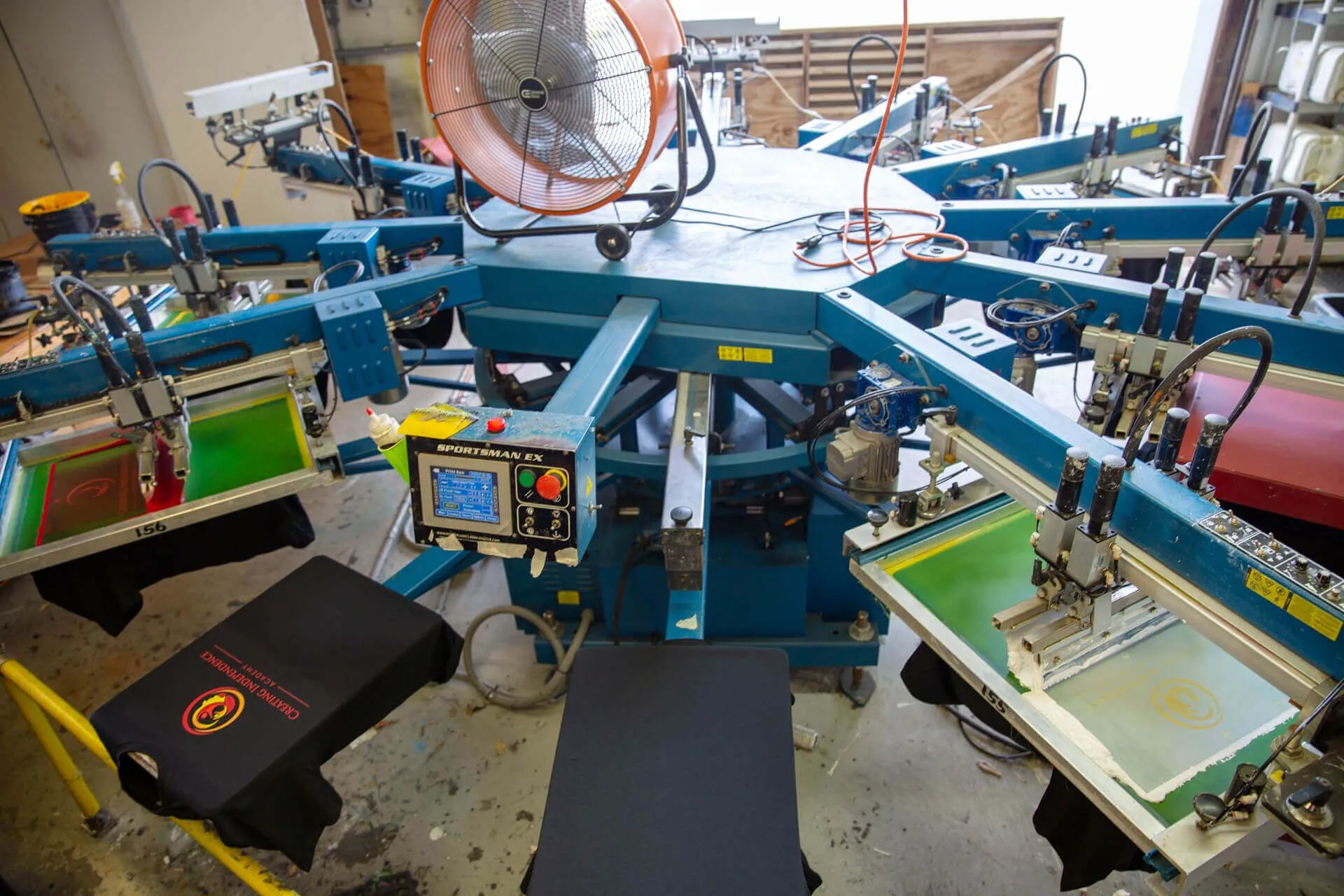Fast Turnaround Custom Screen Printing for Events
Wiki Article
Display Printing Uncovered: Whatever You Need to Find Out About Tee and Garment Printing Methods
If you've ever before asked yourself exactly how those lively styles wind up on your favored tees, you remain in the ideal area. Screen printing is an interesting method that combines art with method, supplying endless opportunities for creativity. Understanding the principles, from equipment to ink options, can greatly affect your results. Prepared to explore the important components that make screen publishing an art form? Allow's reveal the information that can raise your tasks.
The Essentials of Screen Printing: Just How It Functions
When you dive into screen printing, you'll discover it's both an art and a science. At its core, screen printing entails developing a stencil, or screen, that permits ink to go through only in specific areas (screen printing kit). You begin by selecting your layout and preparing your display with a light-sensitive emulsion. When you subject this emulsion to light, it solidifies, leaving your style as an unfavorable area.Next, you'll mix your inks and prepare your printing surface area. Placement the display over the material, then make use of a squeegee to press ink via the display onto the garment. This process calls for accuracy, as you desire clear, lively prints. After printing, you'll heal the ink with heat, guaranteeing it follows the textile and lasts through washes. Each step is necessary, and understanding them will certainly elevate your screen printing skills, changing easy garments into unique, meaningful items.
Kinds Of Display Printing Techniques
As soon as you comprehend the fundamentals of display printing, it's time to explore the various techniques that can elevate your styles. One prominent technique is conventional display printing, where ink is pushed via a stenciled screen.If you're going for great information, consider discharge printing. This method eliminates dye from the textile, leaving a soft, classic look. One more choice is plastisol printing, recognized for its resilience and dazzling colors, making it a favored for lots of brands. Experiment with halftone printing to create gradient results and complex designs. Each technique has its one-of-a-kind charm, so do not be reluctant to attempt them bent on discover what matches your style best!
Necessary Devices for Screen Printing
To accomplish magnificent lead to display printing, having the best tools is basic. You'll require a durable screen printing frame, which holds the mesh that transfers your design onto the garment. Next off, spend in high-quality mops; these are vital for applying ink evenly across the display. You'll additionally need a good direct exposure unit to produce your displays, as well as a washout booth for cleaning them after use. A reputable warm resource, like a conveyor dryer or warmth press, is crucial for treating your prints to guarantee durability. Do not fail to remember a correct work area, equipped with tables and storage space for your materials. Finally, safety gear, such as masks and handwear covers, will certainly maintain you safe from chemicals and inks. With the right tools, you'll be well on your way to creating professional-quality prints.Picking the Right Inks and Materials
When picking inks and products for display printing, you need to take into consideration the kind of ink that works best for your job. Think of textile compatibility to guarantee your layouts look excellent and last lengthy. Also, check out green ink alternatives to make your printing procedure more sustainable.Kinds of Display Inks
Choosing the appropriate screen ink is necessary for attaining dynamic, resilient prints that fulfill your job's requirements. There are several kinds of screen inks to examine. Plastisol ink is popular for its versatility and simplicity of usage, supplying excellent color opacity on dark fabrics. Water-based ink, on the other hand, provides a softer feel and is green, making it ideal for those looking to minimize their environmental impact. Discharge inks eliminate color from the fabric, leading to a soft, classic appearance however call for specific handling. Specialized inks, such as glow-in-the-dark or metallic, can include special effects to your designs. Examine your task requirements and pick the ink that lines up best with your wanted end result.
Textile Compatibility Factors To Consider
Understanding material compatibility is vital for achieving premium screen prints, especially because various materials react distinctively to various inks. When choosing inks, think about the fabric type-- cotton, polyester, or blends. For cotton, water-based inks function well, providing softness and breathability. Polyester, on the other hand, often needs plastisol inks for better bond and dynamic shades. If you're printing on blends, you may need to use a mix of both kinds. Constantly check your inks on example material to guarantee they adhere appropriately and preserve color integrity. Additionally, bear in mind that material weight and appearance can influence the last result, so choosing the appropriate ink and product combo is crucial for your job's success.Eco-Friendly Ink Options
Eco-friendly inks are coming to be a popular selection for screen printers who want to minimize their ecological effect while preserving quality. When selecting inks, think about water-based inks, which are less harmful and simpler to cleanse up compared to typical solvents.In addition, search for inks made from renewable energies, such as soy or vegetable-based choices. By selecting the ideal inks and materials, you'll not only create spectacular designs yet additionally add to a much more lasting printing process. Make the switch, and your prints will reflect your commitment to the atmosphere!
Preparing Your Style for Display Printing

Submit Style Requirements
To guarantee your design looks dynamic and sharp on textile, you'll need to pay close focus to submit format needs for display printing. Make certain your design has a transparent history to prevent undesirable white sides on t-shirt printing your prints. Keep color modes in mind; CMYK is typical for screen printing, so transform your RGB designs accordingly.Color Separation Techniques
Color separation is a necessary action in preparing your design for display printing, and mastering it can considerably improve your print quality. You'll require to damage your layout right into individual shades, as each color requires a different screen during printing. Begin by determining all the shades in your style and develop layers for each one. You can make use of software like Adobe Photoshop or Illustrator to isolate and separate colors efficiently. Be specific to save each layer as a different documents, usually in a layout like TIFF or PSD. This accuracy not just guarantees accurate color representation however likewise enhances the printing procedure. By taking note of color splitting up, you'll accomplish professional and vivid lead to your screen-printed garments.Resolution and Dimension
Accomplishing the most effective lead to display printing begins with guaranteeing your layout has the appropriate resolution and size. Preferably, your art work should be at the very least 300 DPI (dots per inch) for sharp, clear prints. Your final item could look pixelated and unprofessional. if you make use of lower resolution.When it pertains to dimension, consider the measurements of your print location. Design your art work to match the last print dimension, ideally developing it in the real dimensions you'll be publishing. In this manner, you'll stay clear of any unexpected scaling issues.
Always check your style in both vector and raster formats. Vector graphics can be scaled without losing quality, making them optimal for screen printing. Preparing properly will guarantee your design looks amazing on every garment!
Step-by-Step Screen Printing Refine
Screen printing is a dynamic procedure that allows you to produce lively styles on numerous surface areas. To obtain begun, you'll need a screen, emulsion, and your chosen ink. Prepare your display by cleansing it extensively. Next off, use the emulsion uniformly and let it dry in a dark area. As soon as completely dry, reveal your screen to light with your design positioned on it, which will harden the solution where the light hits, producing a pattern - screen printing kit.After rinsing the unexposed solution, your display is ready. Establish it up on your printing surface area and align your garment below it. Put ink onto the display and utilize a squeegee to push the ink via the stencil onto the material. Raise the display carefully and allow the print completely dry. Finally, cure the ink making use of heat to assure longevity. That's it! You've efficiently display published your design.
Tips for Effective Display Printing Projects
While you're diving right into your screen printing tasks, keep in mind that prep work is vital to success. Beginning by gathering all your products-- inks, displays, garments, and mops. A tidy work space helps prevent unwanted errors, so neat up prior to you start.Following, validate your artwork is high-resolution and appropriately sized for your garment. Evaluate your display for appropriate exposure and tidy it completely to prevent smudges. When mixing your inks, adhere to the producer's standards to attain the best uniformity.
Throughout printing, apply even stress with your squeegee for regular results. Don't hurry; take your time to confirm each print fulfills your standards. After printing, let your garments completely dry totally prior to dealing with or packaging them.
Finally, always keep a sample of your job for future reference. In this manner, you can assess your progress and enhance your strategies over time. Pleased printing!

Often Asked Questions
The length of time Does It Require To Establish a Display Printing Work?
Establishing a display printing work normally takes around half an hour to an hour. You'll prepare the screens, mix inks, and change journalism. The time differs based upon intricacy and experience, so stay organized!Can I Print on Different Fabric Enters Using the Exact Same Method?
Yes, you can print on different fabric types utilizing the same technique, however you'll require to readjust your setups and inks. Some textiles soak up ink differently, so trying out warranties the very best results for every material.What Are Typical Blunders to Prevent in Display Printing?
When display printing, stay clear of usual errors like using the incorrect ink, overlooking proper direct exposure times, or missing pre-press checks. Constantly test your configuration and preserve clean displays to guarantee quality outcomes each time.Exactly How Can I Appropriately Tidy and Preserve My Display Printing Equipment?
To effectively clean and preserve your display printing equipment, you need to routinely clean displays with proper solvents, check mops for wear, and guarantee all devices are stored dust-free and dry. Consistency avoids expensive repair services and boosts efficiency.Is Display Printing Environmentally Friendly Contrasted to Various Other Techniques?
Display printing can be a lot more environmentally friendly than other approaches, particularly if you use eco-conscious products and water-based inks. By choosing lasting materials and practices, you lower waste and reduce your effect on the world.Screen Printing Uncovered: Everything You Need to Know Regarding Tee Shirt and Garment Printing Techniques
At its core, display printing includes producing a stencil, or display, that enables ink to pass through only in details areas. Placement the screen over the fabric, after that make use of a squeegee to press ink with the display onto the garment. One popular method is conventional screen printing, where ink is pushed via a stenciled screen.When picking inks and products for screen printing, you need to take right into account the kind of ink that works ideal for your project.
Report this wiki page